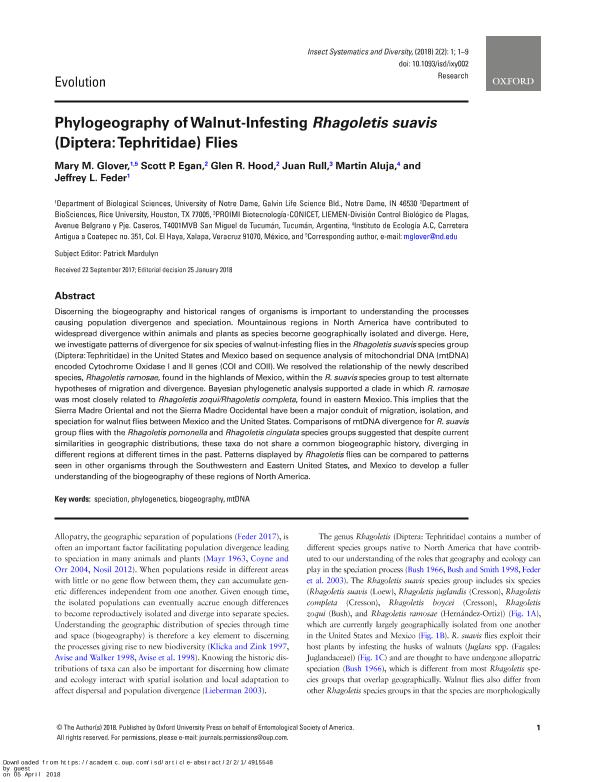Mostrar el registro sencillo del ítem
dc.contributor.author
Glover, Mary M
dc.contributor.author
Egan, Scott P
dc.contributor.author
Hood, Glen R
dc.contributor.author
Rull Gabayet, Juan Antonio

dc.contributor.author
Aluja, Martin
dc.contributor.author
Feder, Jeffrey L
dc.date.available
2019-08-28T14:37:18Z
dc.date.issued
2018-03
dc.identifier.citation
Glover, Mary M; Egan, Scott P; Hood, Glen R; Rull Gabayet, Juan Antonio; Aluja, Martin; et al.; Phylogeography of Walnut-Infesting Rhagoletis suavis (Diptera: Tephritidae) Flies; Oxford; Insect Systematics and Diversity; 2; 2; 3-2018
dc.identifier.uri
http://hdl.handle.net/11336/82356
dc.description.abstract
Discerning the biogeography and historical ranges of organisms is important to understanding the processes causing population divergence and speciation. Mountainous regions in North America have contributed to widespread divergence within animals and plants as species become geographically isolated and diverge. Here, we investigate patterns of divergence for six species of walnut-infesting flies in the Rhagoletis suavis species group (Diptera: Tephritidae) in the United States and Mexico based on sequence analysis of mitochondrial DNA (mtDNA)encoded Cytochrome Oxidase I and II genes (COI and COII). We resolved the relationship of the newly described species, Rhagoletis ramosae, found in the highlands of Mexico, within the R. suavis species group to test alternatehypotheses of migration and divergence. Bayesian phylogenetic analysis supported a clade in which R. ramosae was most closely related to Rhagoletis zoqui/Rhagoletis completa, found in eastern Mexico. This implies that theSierra Madre Oriental and not the Sierra Madre Occidental have been a major conduit of migration, isolation, and speciation for walnut flies between Mexico and the United States. Comparisons of mtDNA divergence for R. suavisgroup flies with the Rhagoletis pomonella and Rhagoletis cingulata species groups suggested that despite current similarities in geographic distributions, these taxa do not share a common biogeographic history, diverging indifferent regions at different times in the past. Patterns displayed by Rhagoletis flies can be compared to patterns seen in other organisms through the Southwestern and Eastern United States, and Mexico to develop a fullerunderstanding of the biogeography of these regions of North America.
dc.format
application/pdf
dc.language.iso
eng
dc.publisher
Oxford
dc.rights
info:eu-repo/semantics/openAccess
dc.rights.uri
https://creativecommons.org/licenses/by-nc-sa/2.5/ar/
dc.subject
Speciation
dc.subject
Phylogenetics
dc.subject
Biogeography
dc.subject
Mtdna
dc.subject.classification
Zoología, Ornitología, Entomología, Etología

dc.subject.classification
Ciencias Biológicas

dc.subject.classification
CIENCIAS NATURALES Y EXACTAS

dc.title
Phylogeography of Walnut-Infesting Rhagoletis suavis (Diptera: Tephritidae) Flies
dc.type
info:eu-repo/semantics/article
dc.type
info:ar-repo/semantics/artículo
dc.type
info:eu-repo/semantics/publishedVersion
dc.date.updated
2019-08-27T13:28:38Z
dc.identifier.eissn
2399-3421
dc.journal.volume
2
dc.journal.number
2
dc.journal.pais
Estados Unidos

dc.description.fil
Fil: Glover, Mary M. University of Notre Dame-Indiana; Estados Unidos
dc.description.fil
Fil: Egan, Scott P. Rice University; Estados Unidos
dc.description.fil
Fil: Hood, Glen R. Rice University; Estados Unidos
dc.description.fil
Fil: Rull Gabayet, Juan Antonio. Consejo Nacional de Investigaciones Científicas y Técnicas. Centro Científico Tecnológico Conicet - Tucumán. Planta Piloto de Procesos Industriales Microbiológicos; Argentina
dc.description.fil
Fil: Aluja, Martin. Instituto de Ecología A.c.; México
dc.description.fil
Fil: Feder, Jeffrey L. University of Notre Dame-Indiana; Estados Unidos
dc.journal.title
Insect Systematics and Diversity
dc.relation.alternativeid
info:eu-repo/semantics/altIdentifier/url/https://academic.oup.com/isd/article-abstract/2/2/1/4915548?redirectedFrom=fulltext
dc.relation.alternativeid
info:eu-repo/semantics/altIdentifier/doi/https://dx.doi.org/10.1093/isd/ixy002
Archivos asociados
